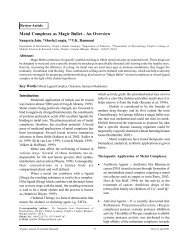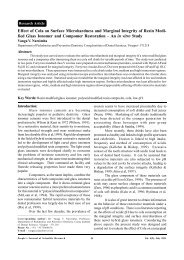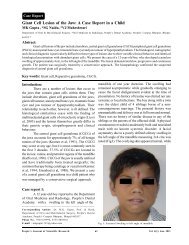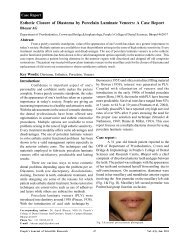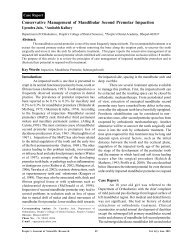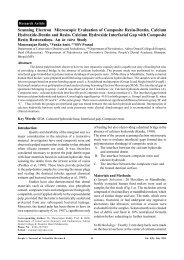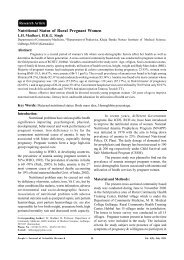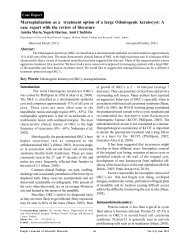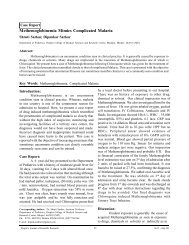Impaction of the Maxillary Central Incisor Associated - People's ...
Impaction of the Maxillary Central Incisor Associated - People's ...
Impaction of the Maxillary Central Incisor Associated - People's ...
You also want an ePaper? Increase the reach of your titles
YUMPU automatically turns print PDFs into web optimized ePapers that Google loves.
<strong>Impaction</strong> <strong>of</strong> <strong>the</strong> <strong>Maxillary</strong> <strong>Central</strong> <strong>Incisor</strong> <strong>Associated</strong> ------- R.M. Shetty, UDixit, H. Reddy, Shivaprakash P. K., B. Kaur<br />
gingival contour (Fig. XI) and <strong>the</strong> tooth maintained its<br />
vitality with no evidence <strong>of</strong> root resorption (Fig. X).<br />
At six-month follow up (Fig. XI), <strong>the</strong> left maxillary<br />
incisor remained vital and responded normally to<br />
percussion and mobility and sensitivity testing with good<br />
width <strong>of</strong> attached gingiva.<br />
Discussion:<br />
Supernumerary teeth can affect <strong>the</strong> normal<br />
position and eruption <strong>of</strong> adjacent teeth and <strong>of</strong>ten require<br />
clinical intervention (Harris and Clark, 2008). The most<br />
common complication due to presence <strong>of</strong><br />
supernumerary teeth is <strong>the</strong> failure <strong>of</strong> eruption <strong>of</strong><br />
maxillary incisors (Rajab and Hamdan 2002).<br />
Supernumerary teeth in <strong>the</strong> premaxillary region are<br />
broadly <strong>of</strong> two types: one containing teeth <strong>of</strong> normal<br />
morphology known as supplemental teeth and <strong>the</strong> o<strong>the</strong>r<br />
<strong>of</strong> abnormal shape. The latter class has been fur<strong>the</strong>r<br />
categorized into <strong>the</strong> conical type (peg-shaped) and <strong>the</strong><br />
tuberculate type. The tuberculate supernumerary tooth<br />
seems to occur most frequently palatal to <strong>the</strong> upper<br />
central incisor and to be later in its development than<br />
<strong>the</strong> conical tooth. It also tends to delay or prevent <strong>the</strong><br />
eruption <strong>of</strong> <strong>the</strong> corresponding permanent central incisor,<br />
and is rarely seen erupted in childhood. It has also been<br />
documented that <strong>the</strong> conical-shaped supernumerary<br />
tooth does not usually affect <strong>the</strong> eruption <strong>of</strong> <strong>the</strong> adjacent<br />
permanent incisors but may cause <strong>the</strong>ir displacement,<br />
which may involve <strong>the</strong> crown, <strong>the</strong> root or <strong>the</strong> whole<br />
tooth. The conical supernumerary may be non-inverted<br />
or inverted. When non-inverted, it may remain<br />
unerupted palatal to <strong>the</strong> permanent incisors. When<br />
inverted, it may point posteriorly towards <strong>the</strong> nose or<br />
may even erupt into <strong>the</strong> nose (Mills, 1987; Pr<strong>of</strong>itt, 1992).<br />
In <strong>the</strong> present case <strong>the</strong> associated supernumerary tooth<br />
was conical, non -inverted and impacted on <strong>the</strong> palatal<br />
side and interfered with <strong>the</strong> eruption <strong>of</strong> <strong>the</strong> permanent<br />
tooth.<br />
The treatment protocol available for<br />
management <strong>of</strong> impacted permanent teeth due to<br />
supernumerary teeth are diverse. Methods <strong>of</strong><br />
management <strong>of</strong> crowding or impaction due to<br />
supernumerary tooth are; removal <strong>of</strong> supernumerary<br />
teeth or tooth only, removal <strong>of</strong> supernumerary teeth<br />
and bone overlying impacted teeth, incision <strong>of</strong> fibrous<br />
tissue over <strong>the</strong> alveolar ridge to promote <strong>the</strong> eruption<br />
with or without orthodontic traction (Regezi et al., 2003;<br />
Bhat, 2006).<br />
Spontaneous eruption <strong>of</strong> impacted maxillary<br />
incisors occurs in 54-76% <strong>of</strong> cases when supernumerary<br />
tooth is removed and it <strong>the</strong>re is enough space in <strong>the</strong><br />
dental arch (Crawford, 1997; Garvey et al., 1999).<br />
However, research data indicate that <strong>the</strong> spontaneous<br />
eruption <strong>of</strong> impacted maxillary incisor may take up to<br />
3 years and sometimes orthodontic treatment is<br />
necessary to achieve adequate alignment <strong>of</strong> <strong>the</strong><br />
erupted tooth in <strong>the</strong> dental arch (Witsenburg et al.,<br />
1981; Mason et al., 2000). If <strong>the</strong> root <strong>of</strong> <strong>the</strong> impacted<br />
tooth is still developing, <strong>the</strong> tooth may erupt normally;<br />
but, once <strong>the</strong> root apex has closed, <strong>the</strong> tooth has lost<br />
its potential to erupt (Kokich and Ma<strong>the</strong>ws, 1993). In<br />
<strong>the</strong> present case <strong>the</strong> root formation was almost<br />
complete and because <strong>of</strong> its rotation and labial<br />
placement, it was not desirable to wait for spontaneous<br />
eruption.<br />
After thorough clinical and radiographic<br />
examination, it was decided that <strong>the</strong> present case<br />
required a combination approach comprising <strong>of</strong> both<br />
surgical and orthodontic treatment to bring an unerupted<br />
maxillary central incisor into position as done by various<br />
authors (Cangialosi, 1982; Kamakura et al., 2002;<br />
Kocadereli and Turgut, 2005). Surgical exposures <strong>of</strong><br />
impacted incisors or surgical repositioning have also<br />
been used to bring impacted teeth into occlusion<br />
(Kamakura et al., 2002; Kocadereli and Turgut, 2005).<br />
Combination approach using conservative surgical<br />
treatment and careful orthodontic management to bring<br />
tooth into good position in <strong>the</strong> dental arch has also been<br />
reported with success (Cangialosi, 1982). Hence,<br />
extraction <strong>of</strong> <strong>the</strong> impacted supernumerary tooth was<br />
done and was followed by an innovative orthodontic<br />
traction <strong>of</strong> <strong>the</strong> unerupted permanent central incisor to<br />
bring <strong>the</strong> tooth into proper position in <strong>the</strong> arch.<br />
Three accepted ways <strong>of</strong> surgical exposure<br />
have been suggested by Becker (1998) as:<br />
a. Circular excision <strong>of</strong> <strong>the</strong> oral mucosa immediately<br />
overlying <strong>the</strong> impacted tooth.<br />
b. Apically repositioning <strong>of</strong> <strong>the</strong> raised flap that<br />
incorporates <strong>the</strong> attached gingiva overlying <strong>the</strong><br />
impacted tooth.<br />
c. Closed eruption technique in which <strong>the</strong> raised flap<br />
that incorporates attached gingiva is fully<br />
replaced back in its former position after an<br />
attachment has been bonded to <strong>the</strong> impacted<br />
tooth.<br />
The closed eruption technique has been<br />
favoured by many clinicians who claim that <strong>the</strong><br />
aes<strong>the</strong>tic and periodontal outcome is far more superior<br />
when compared with <strong>the</strong> circular excision and apically<br />
positioned flap technique (Lin, 1999; Uematsu et al.,<br />
2004; Paola et al., 2005). In <strong>the</strong> presented case <strong>the</strong><br />
People’s Journal <strong>of</strong> Scientific Research 54<br />
Vol. 4(1), Jan. 2011




